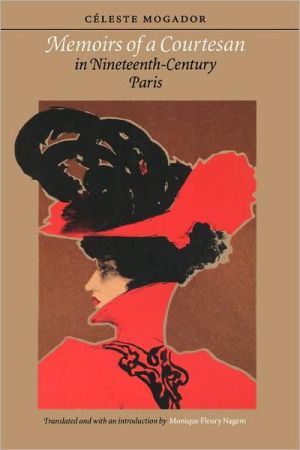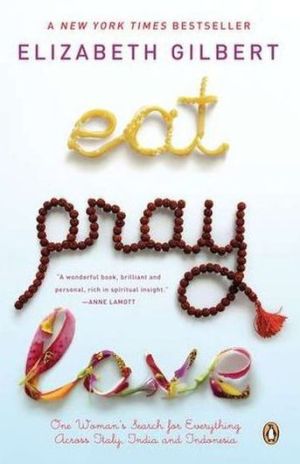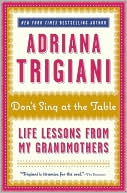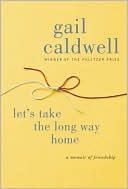Memoirs of a Courtesan in Nineteenth-Century Paris
When Céleste Mogador's memoirs were first published in 1854 and again in 1858, they were immediately seized and condemned as immoral and unsuitable for public consumption. For a reader in our more forgiving times, this extraordinary document offers not only a portrait of the early life of an intelligent, courageous, and infinitely intriguing Frenchwoman but also an exceedingly rare inside look at the world of the courtesans and prostitutes of nineteenth-century France. Writing to...
Search in google:
The memoirs of Celeste Mogador consist largely of long passages of dialogue. This is as true of her account of her impoverished childhood with her mother in Lyon, as it is of her life of ill repute in Paris, where she sought her fortune in gold-digging with great success. Nagem (modern languages, McNeese State U.) provides a summary of Mogador's life in the introduction. In error, Library of Congress cataloguing shows the author as: Chabrillan, Câeleste Vâenard de, comtesse. Annotation © Book News, Inc., Portland, OR Los Angeles Times "Mogador (born Céleste Venard in 1824) was the queen of the Bal Mabille and gained her fame in Parisian dance halls and as an equestrienne, a daring circus rider, at the Hippodrome. Her life, exemplary of bohemian Paris in the 1840s and 1850s, bridges the periods of the Second Republic and the Third Empire. . . . [Mogador's memoirs] contribute to our understanding of how desire was presented and consumed in 19th-century Paris. . . . Refreshing details of daily life are everywhere in these pages, as [Mogador] tells us what was in a bouquet and what she and others wore. She recounts the feints, slights, and homage experienced at a ball, the fevers of the gambling tables, the drama of a boar hunt in the countryside on a nobleman's estate. . . . The settings of social life, high and low, in 19th-century Paris are etched in many memorable passages."
AcknowledgmentsTranslator's Introduction1My Stepfather12The Hunter and the Hunted113The Lyon Insurrection174M. Vincent285Therese406Denise517The Fall638Effects of a Hospital Stay789The Bal Mabille8510A "Queen's" Destiny9411The Hippodrome10412Lise's Yellow Dress11213A Chariot Race13414Travel Impressions14015Acts of Desperation14616Lise's Return15417Dinner at the Cafe Anglais16518Lionel17119In the Country18320Gust of Wind at Le Havre and Masked Ball at the Opera18921Hooray for Reform!19722Roulette20123La Pepine20524The June Insurrection21125Chateau Life21626Richard22127Cholera Gives Me a Godchild23128Dramatic Follies and Folies-Dramatiques23529Proud Women, Passionate Men24230London24931Unfortunate Encounter25632The Girl from the Provinces26233Death Throes of a Fortune26934To the Antipodes27635My Law Lesson28736The Varietes Theater29137A Dead Woman and a Ghost29738A Miner's Diary30239Let My Destiny Be Done!309Index317Works by Celeste de Chabrillan323
\ New York Times Book Review"From the first page, [Mogador] declares her intention to tell the real story of a courtesan's experiences. . . . Céleste's telegraphic, mostly unadorned, literary style supports her claim to authenticity—she was almost entirely uneducated, and at 15 could barely read. But it is the palpable pleasure she takes in seeing people and events clearly, even recognizing her own flaws and those of the people she loves and wishes to think well of, that gives her book the complexity of truth—the kind of complex truth we often look for in modern fiction."—New York Times Book Review\ \ \ \ \ Los Angeles Times"Mogador (born Céleste Venard in 1824) was the queen of the Bal Mabille and gained her fame in Parisian dance halls and as an equestrienne, a daring circus rider, at the Hippodrome. Her life, exemplary of bohemian Paris in the 1840s and 1850s, bridges the periods of the Second Republic and the Third Empire. . . . [Mogador's memoirs] contribute to our understanding of how desire was presented and consumed in 19th-century Paris. . . . Refreshing details of daily life are everywhere in these pages, as [Mogador] tells us what was in a bouquet and what she and others wore. She recounts the feints, slights, and homage experienced at a ball, the fevers of the gambling tables, the drama of a boar hunt in the countryside on a nobleman's estate. . . . The settings of social life, high and low, in 19th-century Paris are etched in many memorable passages."—Los Angeles Times\ \ \ Los Angeles Times"Mogador (born Céleste Venard in 1824) was the queen of the Bal Mabille and gained her fame in Parisian dance halls and as an equestrienne, a daring circus rider, at the Hippodrome. Her life, exemplary of bohemian Paris in the 1840s and 1850s, bridges the periods of the Second Republic and the Third Empire. . . . [Mogador's memoirs] contribute to our understanding of how desire was presented and consumed in 19th-century Paris. . . . Refreshing details of daily life are everywhere in these pages, as [Mogador] tells us what was in a bouquet and what she and others wore. She recounts the feints, slights, and homage experienced at a ball, the fevers of the gambling tables, the drama of a boar hunt in the countryside on a nobleman's estate. . . . The settings of social life, high and low, in 19th-century Paris are etched in many memorable passages."\ \ \ \ \ \ New York Times Book Review"From the first page, [Mogador] declares her intention to tell the real story of a courtesan's experiences. . . . Céleste's telegraphic, mostly unadorned, literary style supports her claim to authenticity—she was almost entirely uneducated, and at 15 could barely read. But it is the palpable pleasure she takes in seeing people and events clearly, even recognizing her own flaws and those of the people she loves and wishes to think well of, that gives her book the complexity of truth—the kind of complex truth we often look for in modern fiction."\ \ \ \ \ \ New York Times Book Review"From the first page, [Mogador] declares her intention to tell the real story of a courtesan's experiences. . . . Céleste's telegraphic, mostly unadorned, literary style supports her claim to authenticity—she was almost entirely uneducated, and at 15 could barely read. But it is the palpable pleasure she takes in seeing people and events clearly, even recognizing her own flaws and those of the people she loves and wishes to think well of, that gives her book the complexity of truth—the kind of complex truth we often look for in modern fiction."—New York Times Book Review\ \ \ \ \ \ Los Angeles Times"Mogador (born Céleste Venard in 1824) was the queen of the Bal Mabille and gained her fame in Parisian dance halls and as an equestrienne, a daring circus rider, at the Hippodrome. Her life, exemplary of bohemian Paris in the 1840s and 1850s, bridges the periods of the Second Republic and the Third Empire. . . . [Mogador's memoirs] contribute to our understanding of how desire was presented and consumed in 19th-century Paris. . . . Refreshing details of daily life are everywhere in these pages, as [Mogador] tells us what was in a bouquet and what she and others wore. She recounts the feints, slights, and homage experienced at a ball, the fevers of the gambling tables, the drama of a boar hunt in the countryside on a nobleman's estate. . . . The settings of social life, high and low, in 19th-century Paris are etched in many memorable passages."—Los Angeles Times\ \ \








